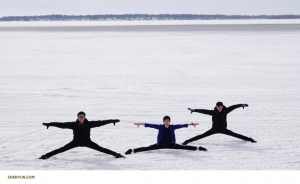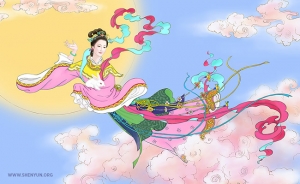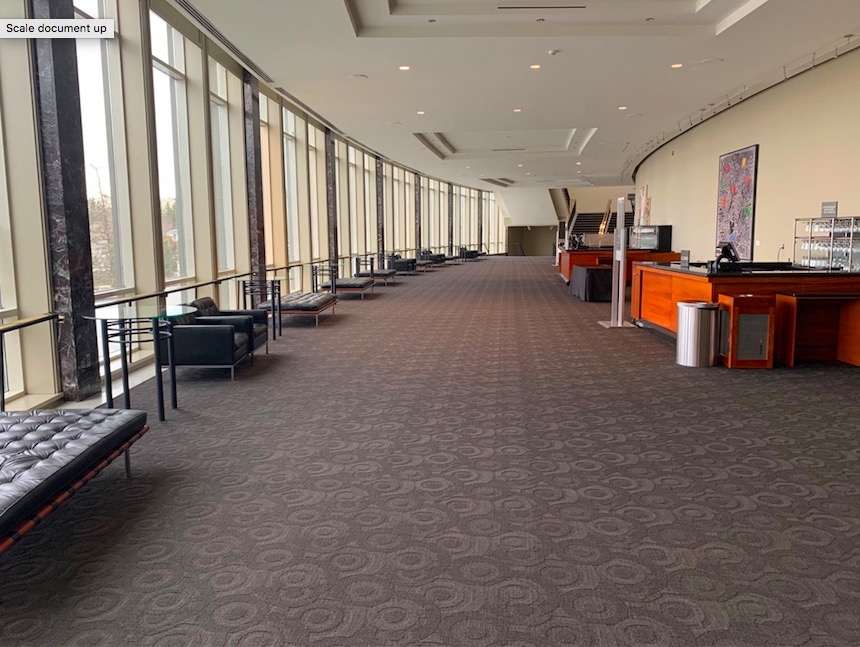
On Tour Daily Diary (Part II)
One post a day from every day on tour. Is there that much to write about? We’ll have to find out. Please leave a comment at the bottom. Hope you enjoy!
March 9.
Have you ever stayed in a hotel room, and then you walked into someone else’s room, or maybe you switched rooms, and the room is exactly the same? The dimensions are the same, the furniture is laid out exactly the same, even the photos on the wall are identical?
Now, what if you stayed in a hotel, say, a Hampton Inn, and you’re in room 231. Then you check out, drive a few hours to your next destination, and check in to another Hampton Inn, where again you’re in room 231. You walk in, and it’s exactly the same. And then you find the orange toothbrush you left in the previous hotel room in the same spot by the sink…
That’s what it’s like going from Edmonton’s North Alberta Jubilee Auditorium (NAJA) to Calgary’s South Alberta Jubilee Auditorium (SAJA).
Let's compare and contrast.
Edmonton Jubilee:

Calgary Jubilee:
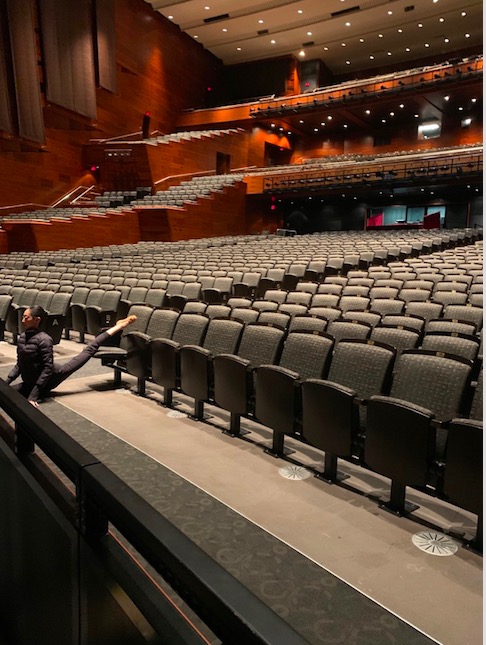
Edmonton Jubilee:
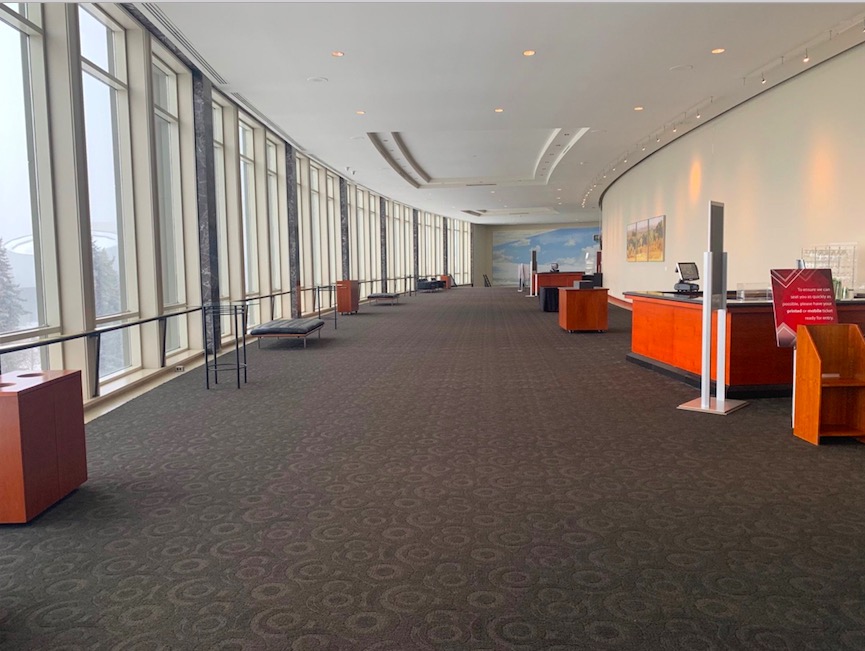
Calgary Jubilee:
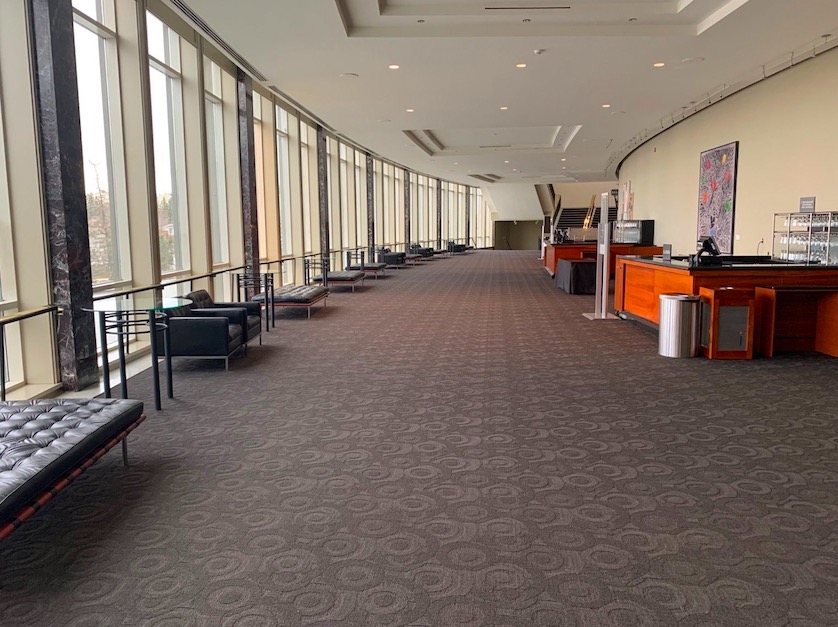
The morning we arrived in Calgary. Before dressing rooms were assigned, all I had to do was just walk back stage, follow the same staircase, go through the same door, make a right down the same hallway, and then a left, and into the same dressing room. Everyone else did the same. I then went up to the stage to look at the hall. Exactly the same as the day before in Edmonton.
NAJA and SAJA. Two jubilees. They are identical twins wearing matching jumpsuits, sneakers, and sunglasses. It’s kinda cool.
Also, the theaters are called the Jubilee. Or the Jube, for short.
March 8.
Today I’m going to post a few photos from the North Alberta Jubilee Auditorium in Edmonton, where we just finished performing. This venue is in many ways unremarkable. Don’t get me wrong, it’s a very nice theater with good acoustics, a nice, modern lobby, and reasonable dressing rooms. But there’s something else about this theater that goes beyond it and exists outside its confines. More on that tomorrow.
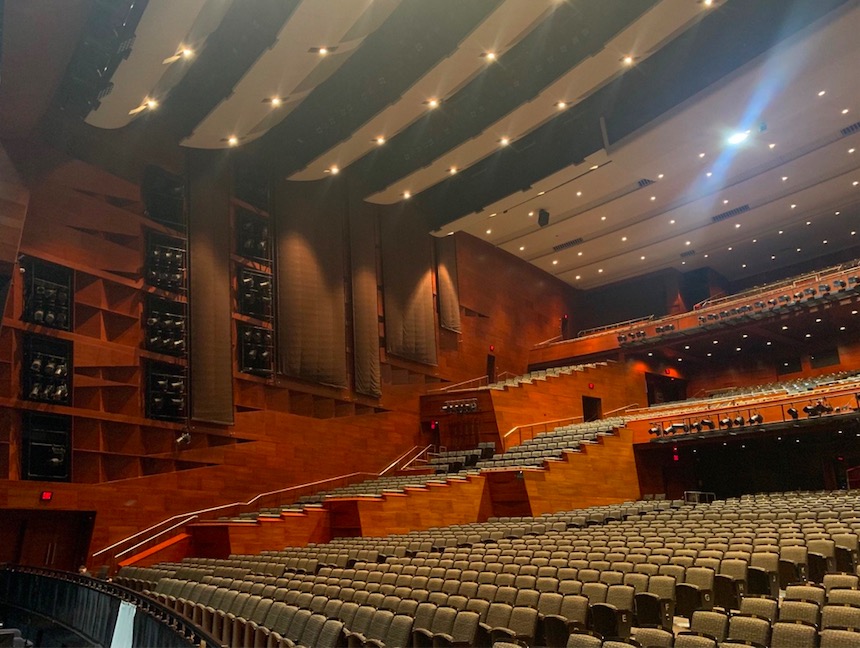

March 7.
Snow, snow, everywhere. We are on our second day in Edmonton, Alberta.
Edmonton, you’ll be happy to know, is a city 1,403 miles from the North Pole. It is only 99 miles from the Arctic Circle. And, like all cities, is 0.2 miles from Starbucks.
This building across the way from the theater is locally known as “The Butter Dome.”

March 6.
Our schedule is not so bad. It really isn’t. We've got a bit of an intense stretch, but even that, by comparison (in just a moment) is not so bad.
Day 1: A 15-hour bus ride from Winnipeg, Manitoba, to Edmonton, Alberta.
Day 2: Early morning setup (leaving the hotel at either 5:20 or 7:15, depending on your role) and working all day and into an evening performance. That’s today.
Day 3: A noon (noon?!) performance. Followed by strike. Followed by a three-hour drive to Calgary. Somehow there’s a Korean BBQ stuck in there somewhere.
Day 4: Early morning setup (leaving at 7:15 or 5:20) followed by an early evening show.
That’s a sample of what life on tour can be like, and the challenges it presents for everyone: long bus rides, long days, and new cities on back-to-back days.
But, like I say, it’s not so bad by comparison.
It’s a lot like minor league baseball life, for example. And it’s not nearly as intense as the Negro leagues.
A century ago, the all African-American baseball leagues had a much more intense schedule than we do. Players would often play one game in one city, then hop on the bus and play another game in another city the same day. Sometimes they would even play a double-header in one city and then another double-header in another city, or even two other cities, making it a seemingly impossible six games in three cities in one day.
Our schedule is not as intense as what famous tenor Guan Guimin once told me his schedule had been. In the 1980s, Mr. Guan was touring with a performing arts troupe. People around China had just come out of the Cultural Revolution and were hungering for some entertainment. So his company would arrive in one town, setup a makeshift stage, perform for an hour or two, then drive to another city and do the same. It wasn’t uncommon for them to be in five towns in one day. Performances started at all hours: 3:00am shows, 5:00am shows, you name it. He said some singers were in such a daze that they would go on stage, entirely forget their lyrics, mumble something unintelligible, and walk off to have another drink. So our schedule is not as bad as that.
Our schedule also isn’t as tough as the classic production, the timeless premier performance that has stayed relevant for literally months. I’m talking, of course, about Baby Shark. The Baby Shark Live performance is in a different city every single day. Here’s an example off their website:
March 12 - Appleton, WI
March 13 - Dubuque, IA
March 14 – Peoria, IL
March 15 – Ralston, NE
March 16 – Sioux Falls, SD
March 17 – Grand Forks, ND
March 18 – Rapid City, SD
March 19 – Colorado Springs, CO...
Our trip is quite easy by comparison to Tang Sanzang's, who trekked on foot from China to what is now known as India (and back) on a journey that took him 17 years and inspired the classic novel Journey to the West. He didn’t even have the benefit of Pilot gas stations.
Our schedule is a piece of cake compared to Navy S.E.A.L.S’ hell week, which consists of basically no sleep, running around carrying heavy objects, jumping in and out of the ocean, and being yelled at for five days and nights straight. And they don’t have thousands of people clapping and cheering for them every night.
Our schedule is a walk in the park compared to any soldiers out on the front in any time and any place in history. It’s a breeze compared to first responders in the days following an earthquake.
Our journey is much smoother than Steve Martin’s in Planes Trains and Automobiles, more colorful than Mr. Smith Goes to Washington, and makes way more sense than Citizen Kane.
So what I’m going to do now is get up from this comfortable sofa, grab a snack, and then get back to work in this nice warm theater in the middle of our easy peasy tour.
March 5.
Today is March 5, and it’s an important date to know.
About ten years ago we were performing in Brussels. I was backstage working on my laptop when our company manager, Vina Lee, walked by.
“Did you hear? Liang Zhenxing just died,” she said to me in Chinese.
I hadn’t yet heard. I knew that, of a small band of brothers who set out to do something remarkable, he had been the only one still alive. Now he, too, was gone.
His story goes back to early March 2002. In northeastern China, in a city named Changchun, the persecution of people who practice Falun Gong (Falun Dafa) was at its manic peak. Three years into the Chinese Communist Party’s persecution campaign, Falun Dafa had not been crushed. On the contrary, facing mass arrests, widespread torture, forced labor, and mounting deaths in custody, Falun Gong practitioners from all across China traveled to Tiananmen Square and held banners holding the words “Truthfulness, Compassion, and Tolerance,” the practice’s principles. Others hung banners on trees, posted flyers, or flew balloons with messages dangling beneath them.
“Falun Dafa is good,” they would often say. “Stop the persecution.”
But the machinery of the Chinese Communist Party was relentless. Well-oiled from decades of similar campaigns, most notably Mao’s Cultural Revolution, the propaganda apparatus churned out story after story trying to link Falun Gong to every social malice. On every evening’s news, people who practice Falun Gong were depicted as insane and dangerous. They were demonized to the degree that if friends and family caught their loved ones meditating, they would turn them in to the police.
It was then that the band of brothers—Liu Haibo, Liu Chengjun, Lei Ming, Liang Zhenxing—decided to try something different. Instead of going to Tiananmen Square for ten seconds of banner holding followed by three years in a labor camp, they would take the message directly to the people. They would debunk the Party’s propaganda. They would show the people of Changchun how Falun Gong is practiced freely around the world. How the “self-immolation” was staged. How everyone was being lied to.
Their plan, and the execution of it, is beautifully depicted in Ethan Gutmann’s article “Into Thin Airwaves” which later became a chapter in his seminal book: The Slaughter.
They trained and taught themselves how to climb telephone poles, splice wires, and connect transmitters. And then, in the evening of March 5, 2002, during prime-time television, as families across Chanchun sat down for their daily dose of state-run propaganda, the screen went out for a second. Then a new program appeared.
For 50 minutes the veil of official narrative was lifted and a very different reality was broadcast across eight channels to over a million people. Police ran frantically trying to find where the broadcast was coming from. People crowded around TV sets in convenient stores to watch. For 50 minutes, this little corner of China was free.
The small band of brothers knew what this would mean. They also knew what it would cost. One by one they were captured, tortured, and killed.
Police barged into Liu Haibo’s home, broke his ankle in front of his wife and toddler, dragged him to the police station, and shocked him with an electric baton until he died a few hours later.
Liu Chengjun was shot in the leg while running away, sentenced to 19 years in prison, and died of injuries within a year.
Lei Ming was captured the night of the broadcast. He was bound to iron chair and tortured. He died of spinal injuries three painful years later.And Liang Zhenxing, the leader of the small group, was put on a show trial and sentenced to 19 years in prison. There he was shocked simultaneously with multiple cattle prods and shackled for long periods of time. By 2010 he was emaciated and could barely walk or talk. He passed away on May 1, 2010.
* * *I’ve met a few people from Changchun who knew these people, knew their stories and what they were like as men. They call the March 5 (3/05) broadcast “305.” It’s my hope that this day will be remembered and, one day, celebrated across China.
The above abbreviated version of the story doesn’t come close to doing it justice. For the full description, which is action-packed and based on detailed interviews with those people who knew the 305 group, see Gutmann’s article: Into Thin Airwaves.
March 4.
After a day and half driving over 1,000 miles from St. Louis, back through Minnesota, and across the border into Canada, we arrived at very snowy Winnipeg.
“Have we performed here before?” someone asked. “I think Shen Yun has, but I don’t know if I have,” someone answered.
In the morning at the theater, our bass, Li Xin, pulled out his camera. “Here, look at this photo,” he says, “I’m pretty sure it’s this hall. I take pictures of every venue I perform in. I was here 10 years ago.”
It had been 10 years between Shen Yun performances in Winnipeg, the capital of Manitoba province. Over those years the local presenter, the Falun Dafa Association of Winnipeg—which is really just a couple of people, tried over and over to bring Shen Yun back. Between scheduling difficulties and availability, a decade went by.
Just to give you a sense of what has changed with Shen Yun since the last time we were here: In 2010 we had three companies. Now we have seven. Back then we didn’t have Shen Yun Symphony Orchestra or Shen Yun Shop. The main theater where we rehearse in New York was not yet built, nor were most of our offices and dance studios. Our colorful buses were plain white. Conductor Milen Nachev was still two years away from joining us. Most of the performers in this group were wrapping up elementary school or at most junior high. I had more hair. A lot has changed.
And finally, they got Shen Yun back in Winnipeg. For one performance.
Volunteers came in from as far as Toronto to help with catering, ticketing, and backstage work.
And the tickets sold well. They sold really well. They sold so well that, just weeks from opening night (which I guess is also closing night), they asked if they could add another show the day before the scheduled one. In spite of the tight travel calendar, the show was added. But the real difficulty would be quickly selling a couple thousand tickets in a relatively small market.
As we set up for the first performance, the local presenters, in all their humility, apologetically warned us—this was a last-minute addition, ticket sales are not what we would like, and so on. But as the curtain came up, the house looked pretty full. They did it.
We have a tradition that, after the final performance in a city, after we strike the stage and get ready to go, we gather in the cafeteria to thank the local presenters and volunteers.
Their representative, and I’m sorry I don’t know his name (we rarely do), said: “A lot of people have been waiting for Shen Yun to come to Winnipeg. Finally you arrived. We hope we don’t have to wait another ten years for the next time.”
March 3.
Shen Yun is from New York. We’ve always been from New York. We’ve always said we’re from New York.
But judging by what some media are saying now, you would think that the fact that we’re saying we're from N.Y. is big news. A paradigm shift. A marketing pivot. A new strategy.
After we issued a press release (link) clarifying that Shen Yun is not from China, performers live in the U.S., and no one has been back to China in a while, therefore we have nothing to do with Coronavirus, a few media outlets treated this like it was a break from what we’ve always said.
If you’re not paying very close attention this can all be confusing. I get it.
‘So, let me get this straight: Shen Yun is a performance of Chinese culture, a celebration of Chinese civilization, but you’re not from China. But the performers are Chinese, but not Chinese-Chinese, or they were Chinese-Chinese but are now U.S.-Chinese, or from Taiwan, which is part of Chinese culture but isn’t part of China today, and in this show you see real Chinese culture but you can’t see the show in China?’
Yes, right. It’s simple.
Here’s the basic logic: - Chinese civilization has a history of roughly five thousand years. - The culture of this civilization has been almost completely destroyed over the last seven decades of Communist Party rule. Some surface traditions remain, but the spiritual essence is gone. - Shen Yun was established in New York in 2006 with the mission of reviving this culture through performing arts. - The artists of Shen Yun are mostly ethnic Chinese from around the world, including from China. - Once they join Shen Yun, they basically cannot go back to China as individuals. - Shen Yun as a company cannot perform in China. - The Chinese Communist Party, through its “diplomatic missions,” as well as spy networks and associations, has been trying to sabotage Shen Yun since the very beginning and never really stopped.
None of this is new. We’ve been saying all of this since the beginning.
On stage, MCs like myself say the following lines in every – single– performance:
“Shen Yun is based in New York. These performers are among the world’s top classical Chinese dancers. They receive their training at the New York-based Fei Tian College and Fei Tian Academy of the Arts, where classical Chinese dance is the foundation of their training.”
We also say this:
“Shen Yun’s mission is to revive genuine traditional culture. Unfortunately, you cannot see a performance like this in China.”
On our website, the first paragraph under the About section reads:
“Shen Yun Performing Arts is the world’s premier classical Chinese dance and music company. Shen Yun was established in New York in 2006 by elite Chinese artists. They came together with a shared vision and passion—to revive the lost world of traditional Chinese culture and share it with everyone.”
And we go into it in more depth in Our Story section.
And even our print marketing materials—flyers and direct mailers—have included anything from a sentence to a whole spread about this.For example, opening literally at random, this flyer from 2013:
“AUTHENTICALLY CHINESE, MADE IN AMERICA. Based in New York, Shen Yun is a nonprofit organization that is reviving authentic Chinese culture. Today, you can no longer see a show like Shen Yun in China.”
I could go on with this for a long time. We’ve always explained this in interviews on TV, radio, newspapers, and magazines, for example, and we’ve done a lot to expose how the Chinese regime has tried to stop us for precisely this reason (more on this in a day or two).
It’s just that with the recent climate of COVID-19 and, even before that, a growing anti-China political sentiment in the U.S., we’ve had to emphasize this point in ALL-CAPS. And BOLD. Maybe even PURPLE.

On Tour Daily Diary (Part II)


